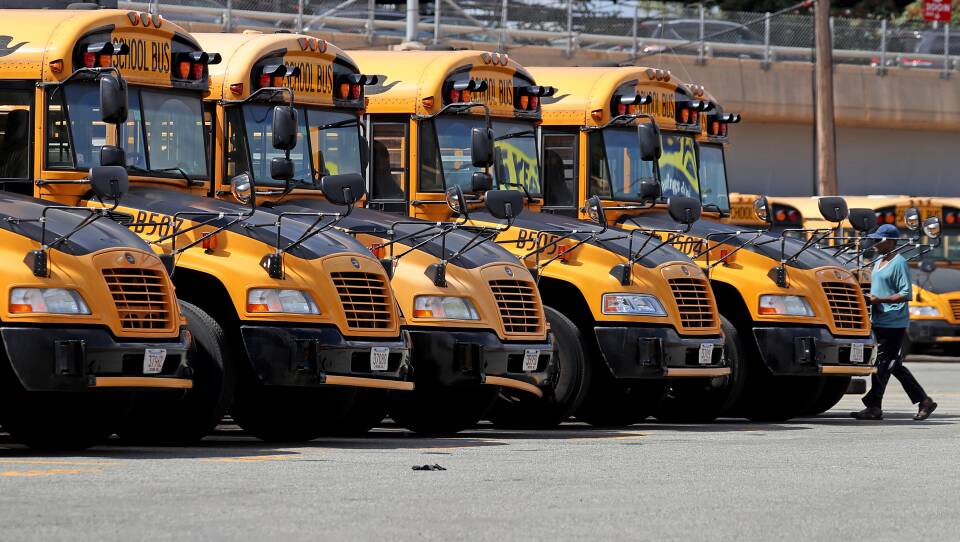Boston Public Schools released an updated draft school reopening plan Wednesday and asked parents, educators and students to express their concerns and give suggestions about possible improvements.
There are no provisons for all students to be in school at the beginning of the school year, as the current plan combines at-home and in-person learning, with students coming to school in shifts.
“We acknowledge there are difficulties with the hybrid plan that we have proposed, but it is the best plan we've got so far,” BPS Superintendent Brenda Cassellius said during a virtual call with reporters Wednesday. “Which is why we're out now, saying please give us your better ideas so that we can incorporate those down and make this plan better, so that it's the best thing for this community when we get to the first day of school.”
The proposed hybrid, or “hopscotch,” model would alternate groups of students for in-person and remote learning, and sanitize the school buildings between groups. Students would sit at desks 6 feet apart and wear masks throughout the day, aside from small assigned “mask breaks.” The groups of students would be broken into categories — groups A and B would alternate days in the building, group C would involve the most in-person learning — likely English language learners, special needs students and vocational students — and group D would be remote-only.
“I can tell you right up front that I can't tell you yet who would ever be in [the all-remote] group,” Senior Advisor Tammy Pust said on the call. “Once we know who Group D is, then we can divide between A's and B's, and we’ll know how many people we can get into classrooms.”
The school committee has a meeting scheduled Wednesday evening, when members of the Boston Teacher’s Union plan to give testimony and express their concerns about the hybrid model. “This hybrid/hopscotch plan is not sustainable or doable or safe for families or educators,” BTU President Jessica Tang said during a video call with more than 500 educators on Monday. “We need to have the phased-in approach.”
As Tang described it, a "phased-in approach" would continue remote learning while securing time and funding for training and continued preparation to bring back in-person learning and adjust to a hybrid model. “We need time to phase in,” Tang said. “That means we need to go slower and get remote learning right.”
Safe air ventilation was one of the biggest concerns raised by teachers during Monday’s BTU meeting, a topic that Cassellius touched on during the call Wednesday.
“We are looking at all types of different technologies and renovations that would need to happen in order to open up school buildings or classrooms within buildings,” Cassellius said. “For instance, you know, we had a number of windows that we identified that needed to be fixed or replaced, and so we are fixing and replacing windows actively and have been doing that during the summer.”
According to the school district's draft plan, teachers will require training on new remote technologies and in-person protocols, and will receive professional development training for a “so far undetermined” number of days prior to the students’ Sept. 10 start date.
“We have teachers who don’t need a lot of professional development because they are really experts in flip learning [and] online learning, they've been doing it for many, many years,” Cassellius said. “We're looking to them to chart the course for all of us and to give us their best advice.”
Assessment testing will be provided remotely to address education gaps that were created at the beginning of the pandemic, when students began remote-only learning and 20% of the city’s student body slipped into truancy.
“People know pretty much how I feel about standardized testing,” Cassellius said, “but I do think in this kind of environment, in order to make sure that we are adequately creating opportunity in all of our schools and equity across our schools, we're going to need to know how well schools are doing.”
Though students will be expected to bring their own masks, Cassellius said BPS is working with community partners, including the Boston Red Sox, to provide PPE to educators and students without their own masks.
Educators will be responsible for ensuring that students respect mask-wearing protocol, Cassellius said, but she wants to avoid a “punitive environment” for mask-wearing. “The best way is preventative,” she said. “We want to make sure children understand the need for it. Children will comply when they know that it is for their own safety and the safety of their friends and the safety of their teachers.”
Public resources are already limited, and Cassellius said cuts will likely need to be made to ensure the new model can work within its budget. “We are going to continue to look at our staffing patterns, we are going to continue to look at our procurement patterns, our supplies, our supply lists,” Cassellius said. “What is it that we can take off the table or keep on the table? What do we need to not do? Let's say we go remote, are there things that we're paying for now that we just don't need in the future? “
Pust and Cassellius released an email address for feedback about the proposed plan, reopening@bostonpublicschools.org, and encouraged the general public to reach out.








